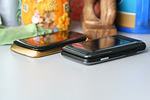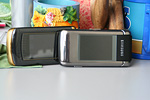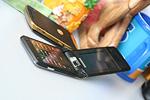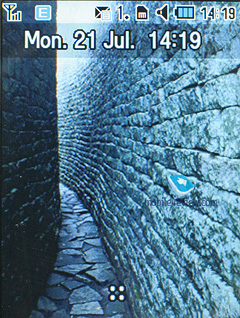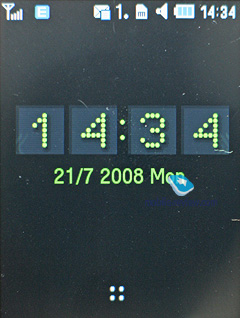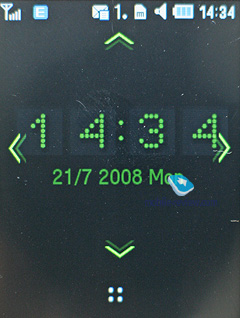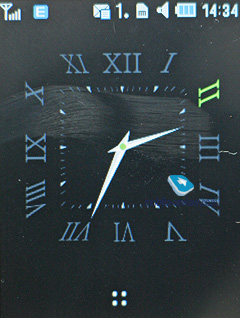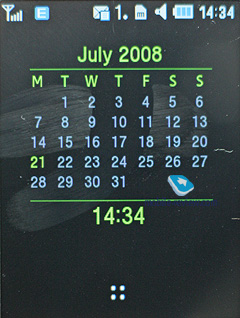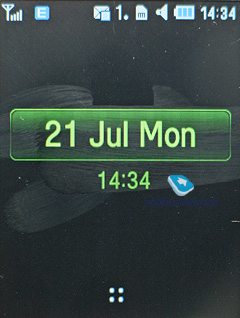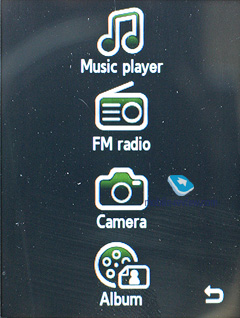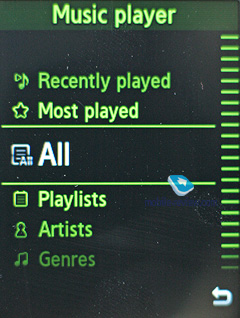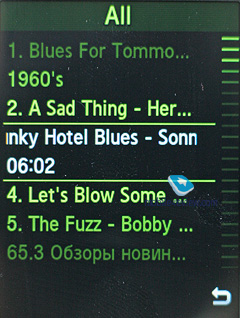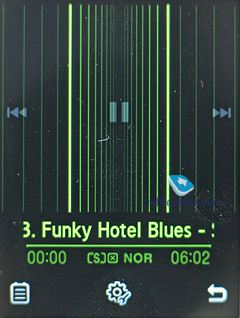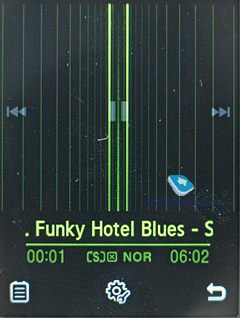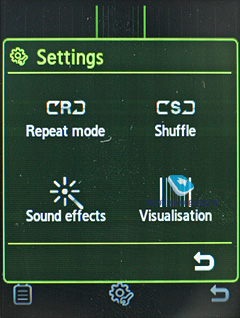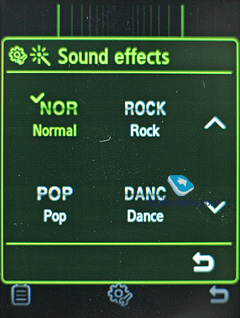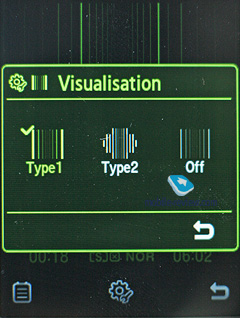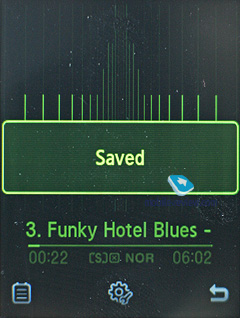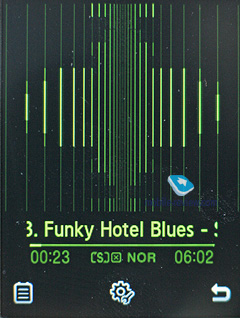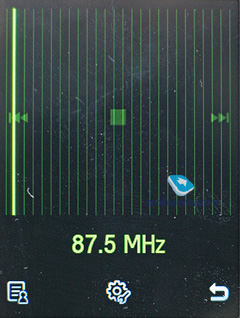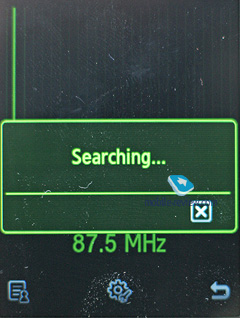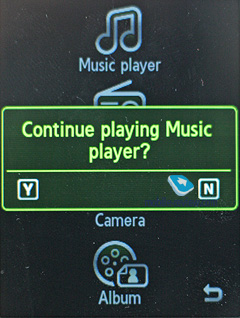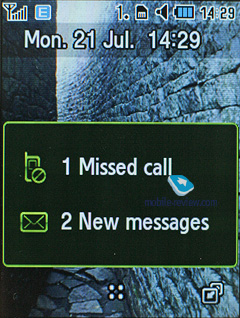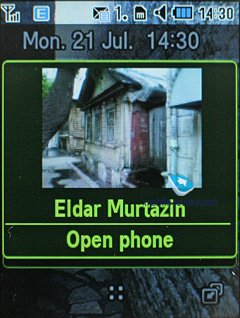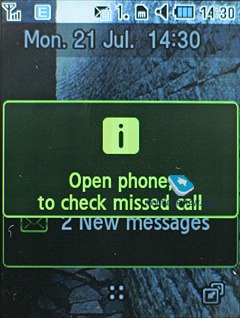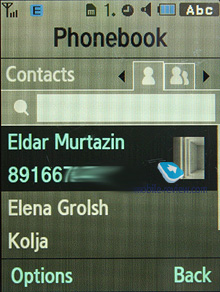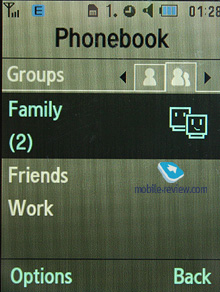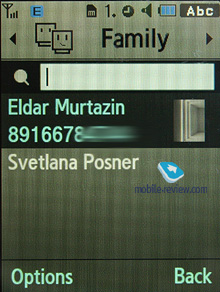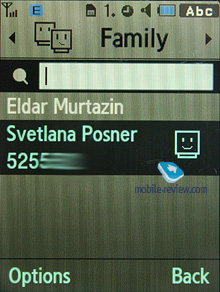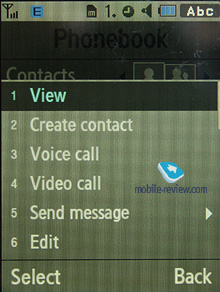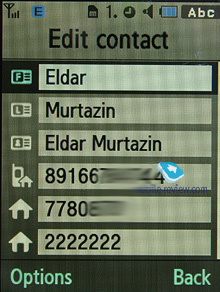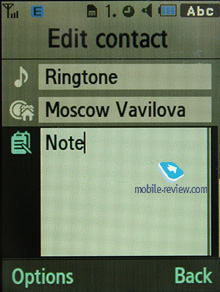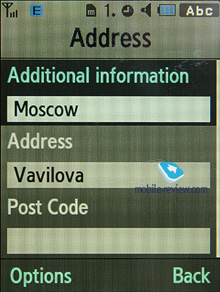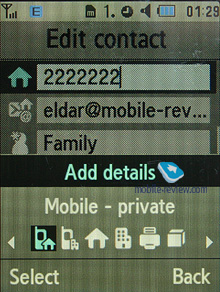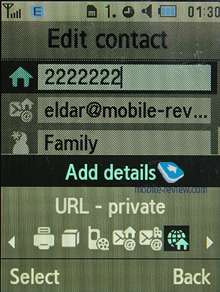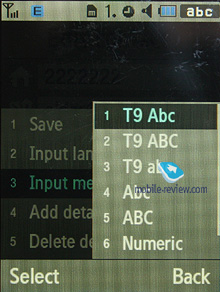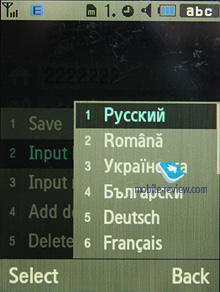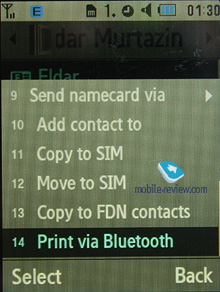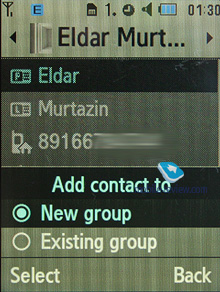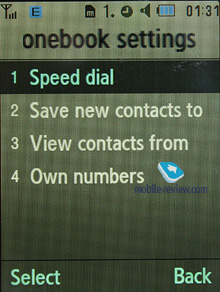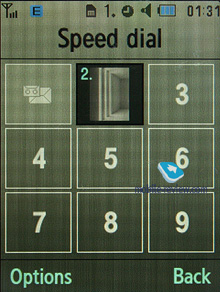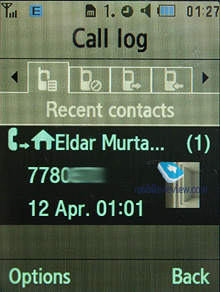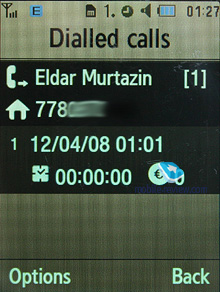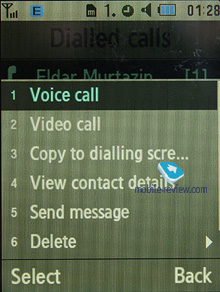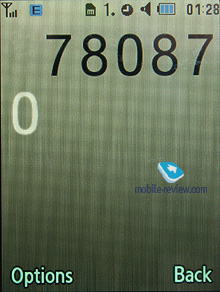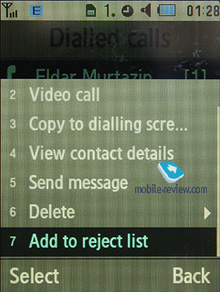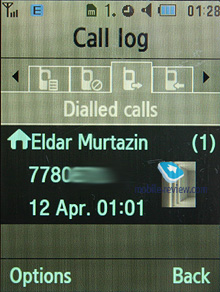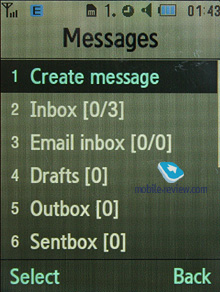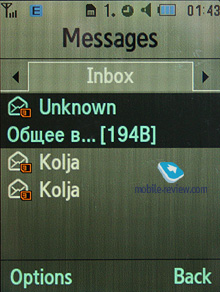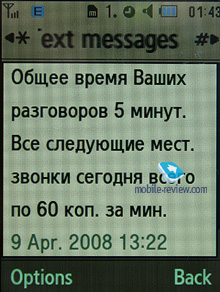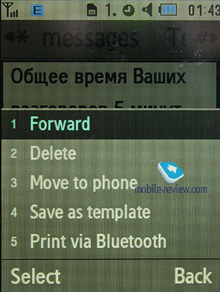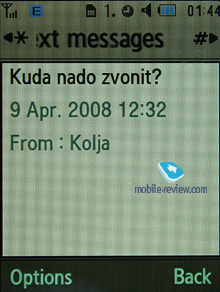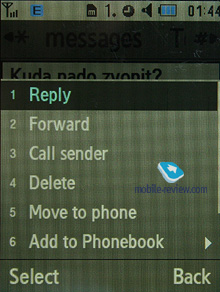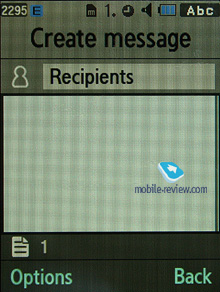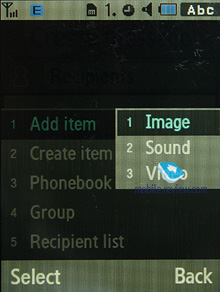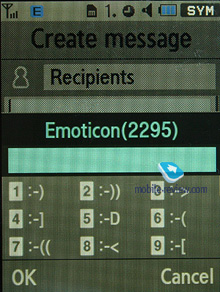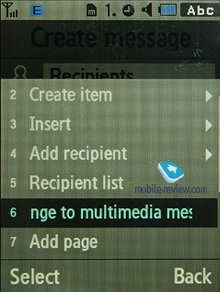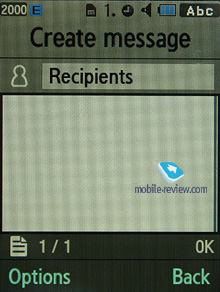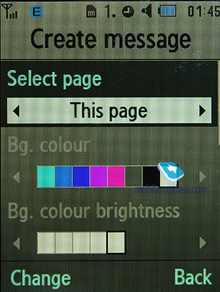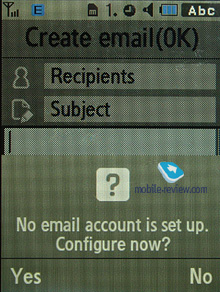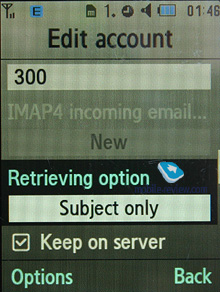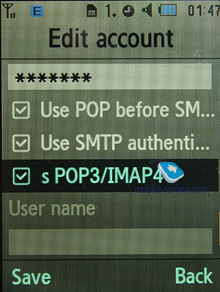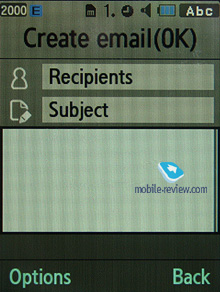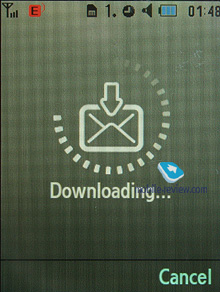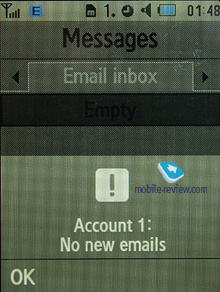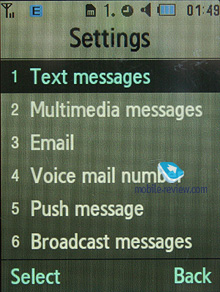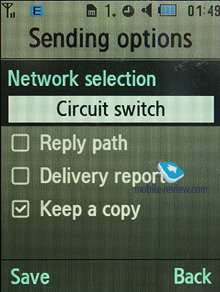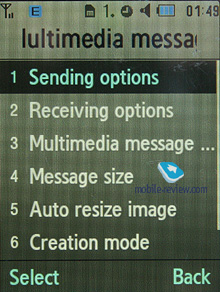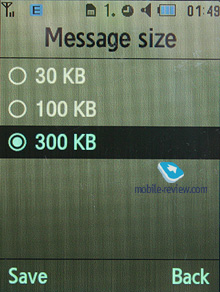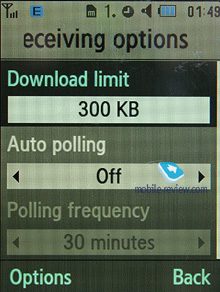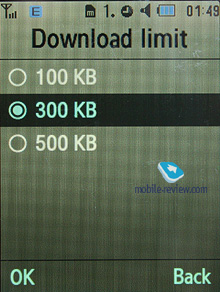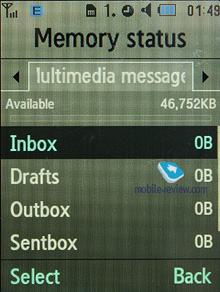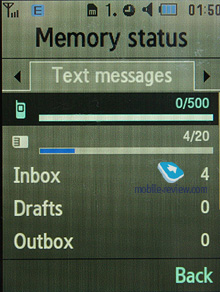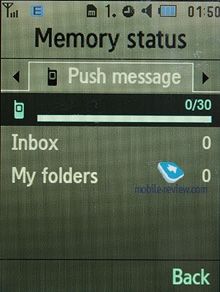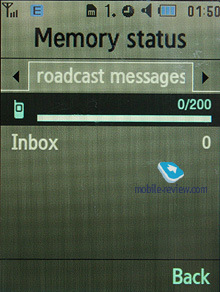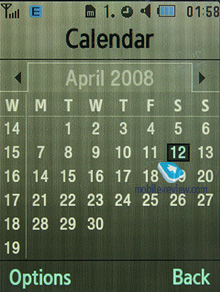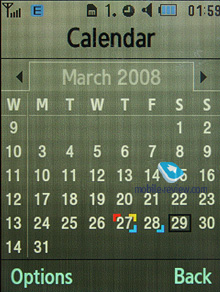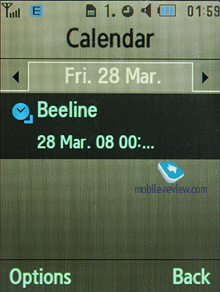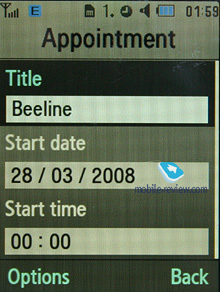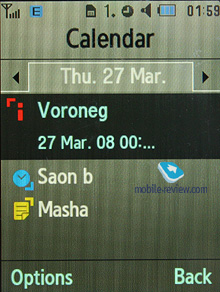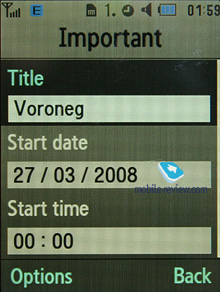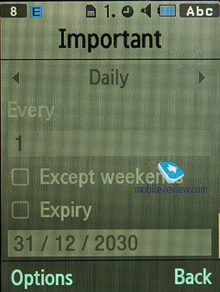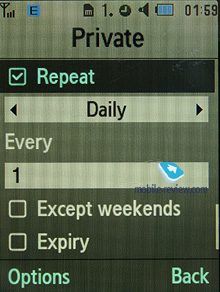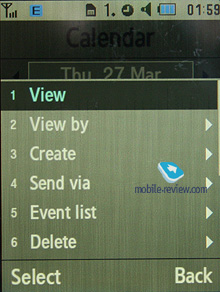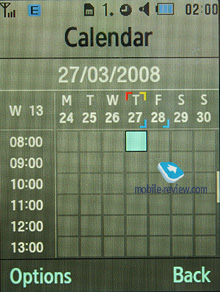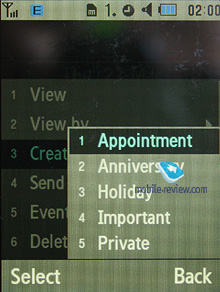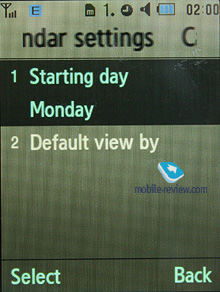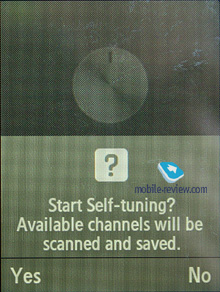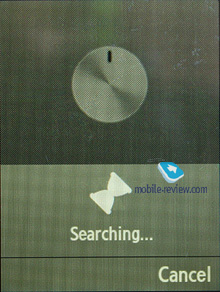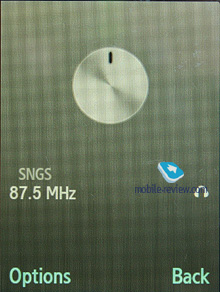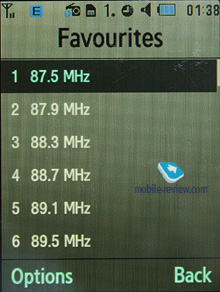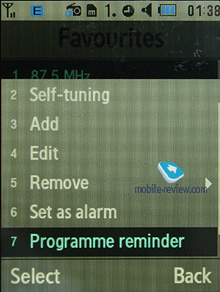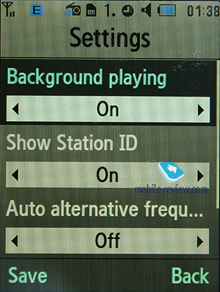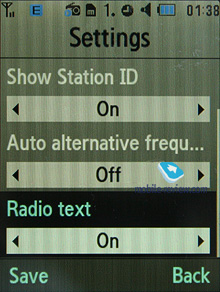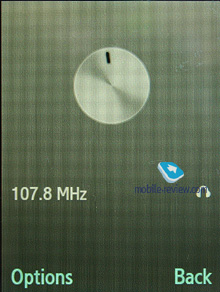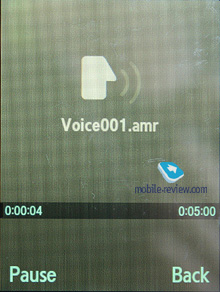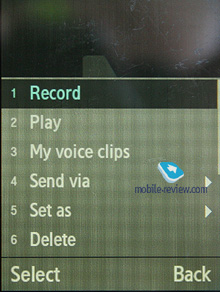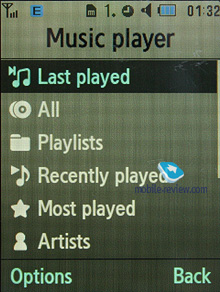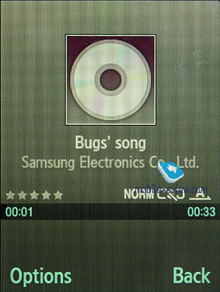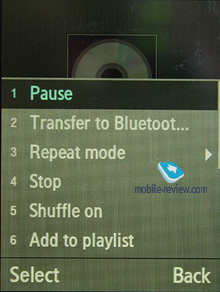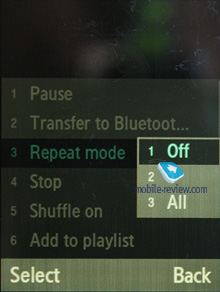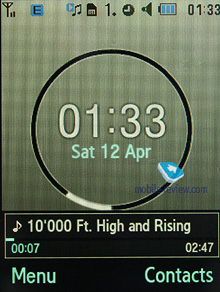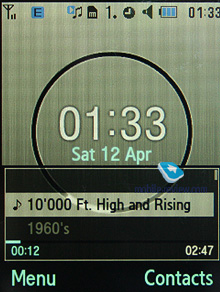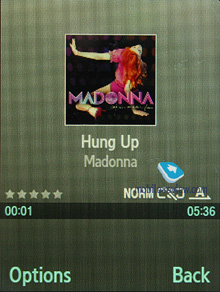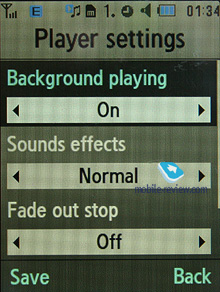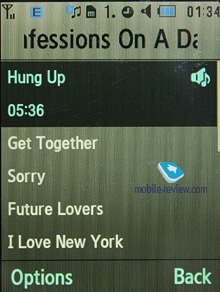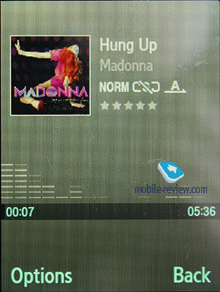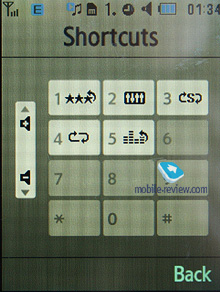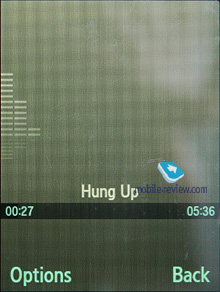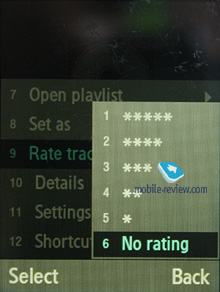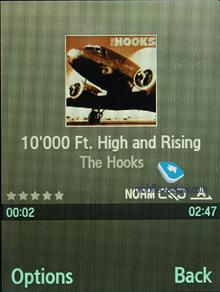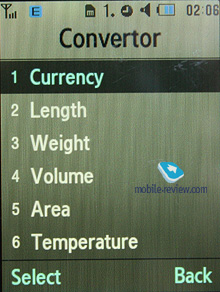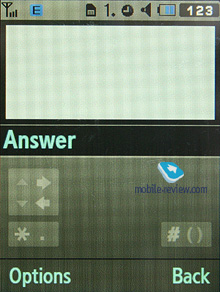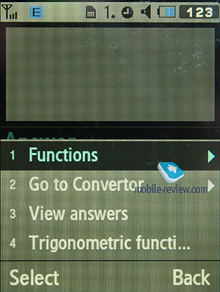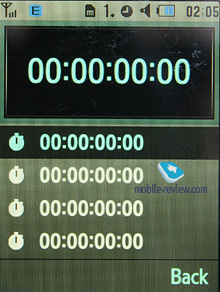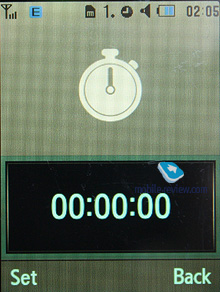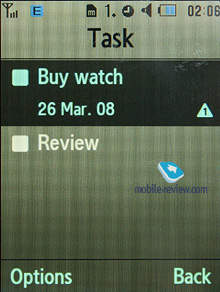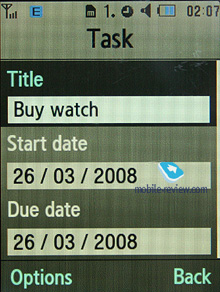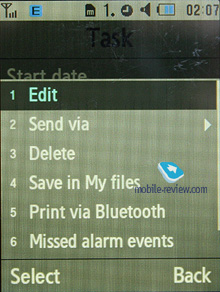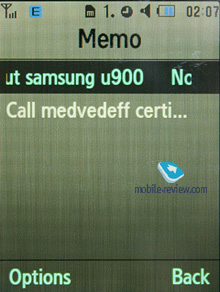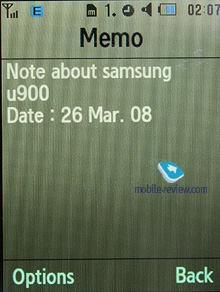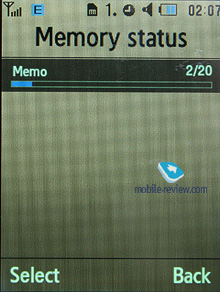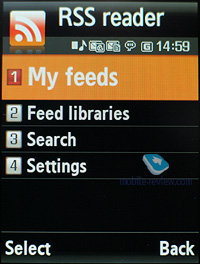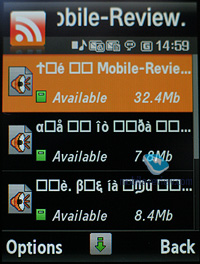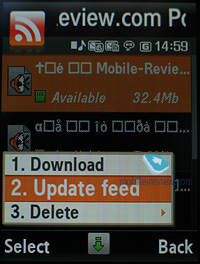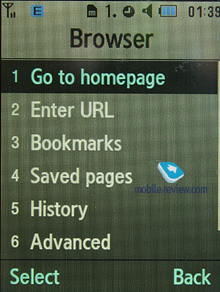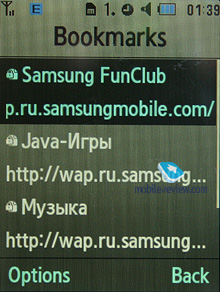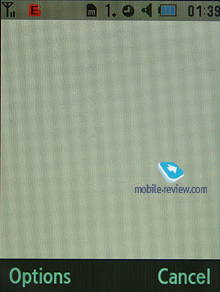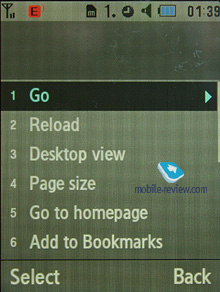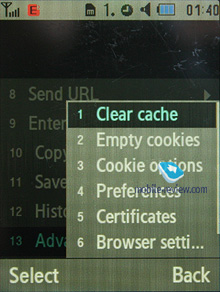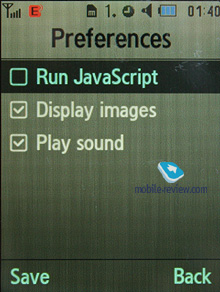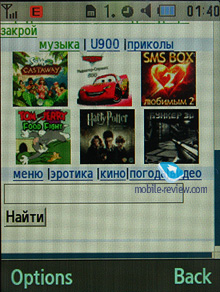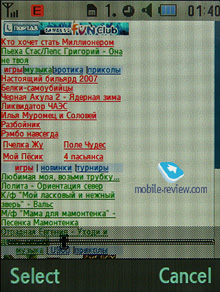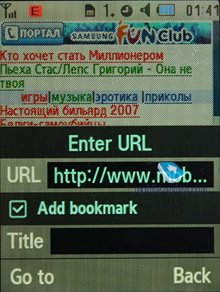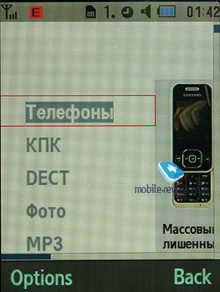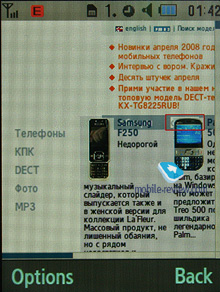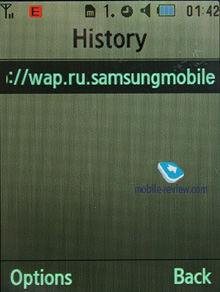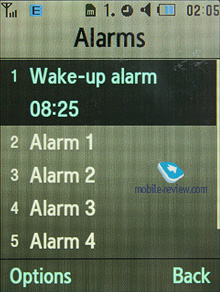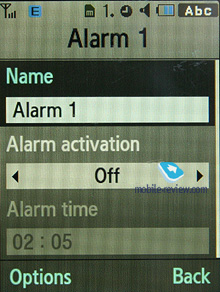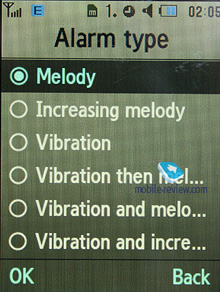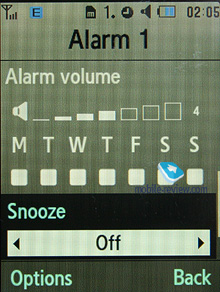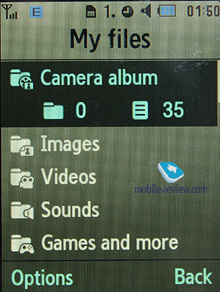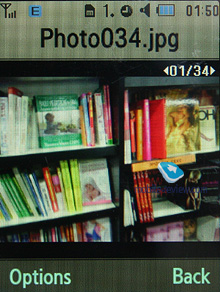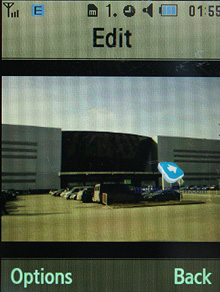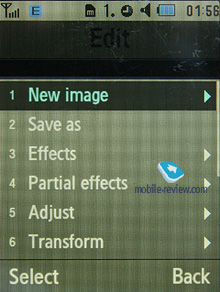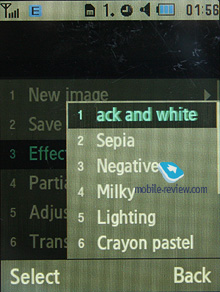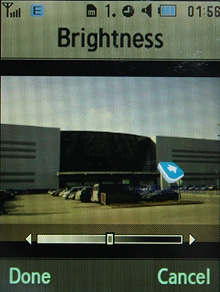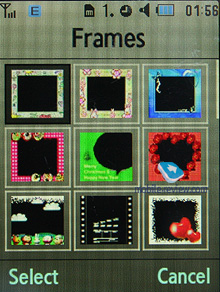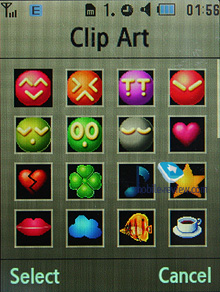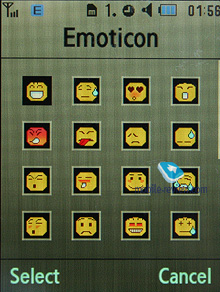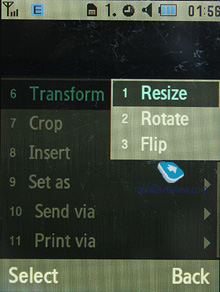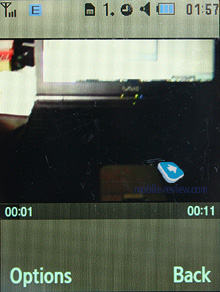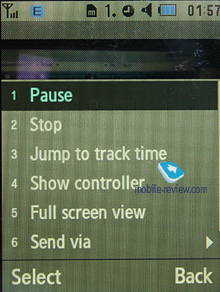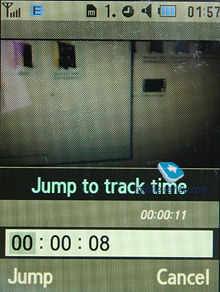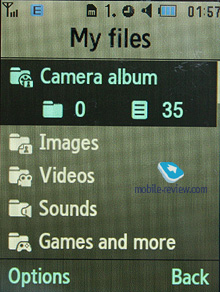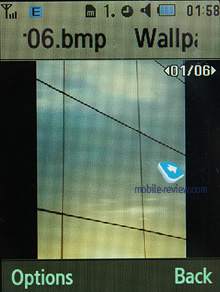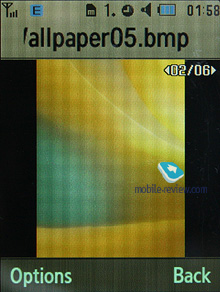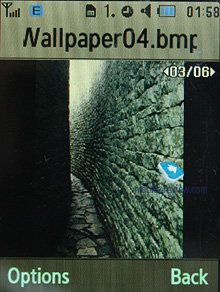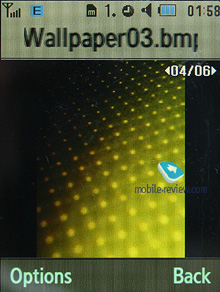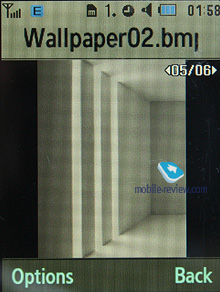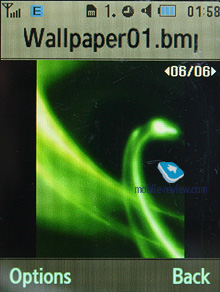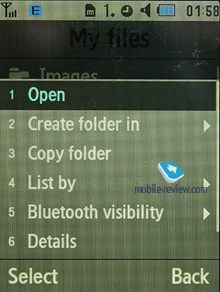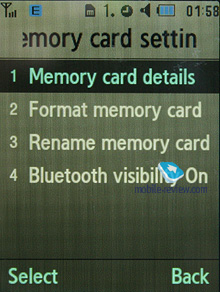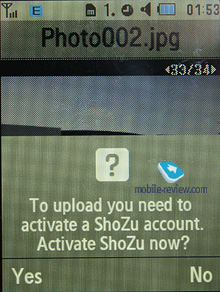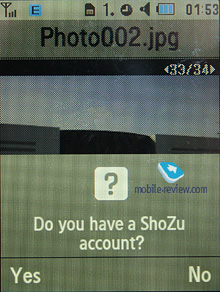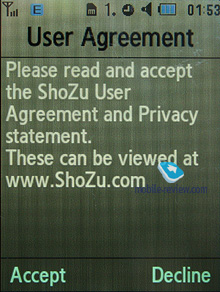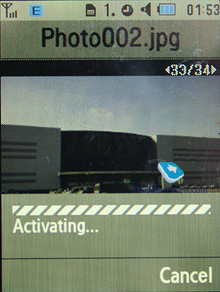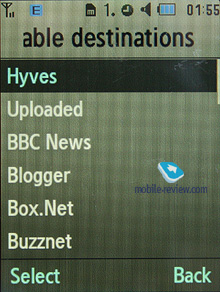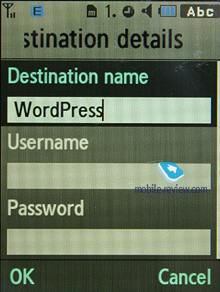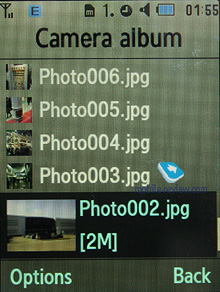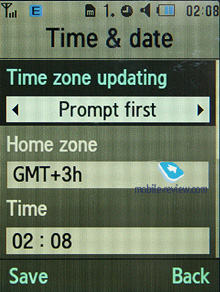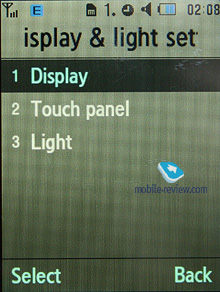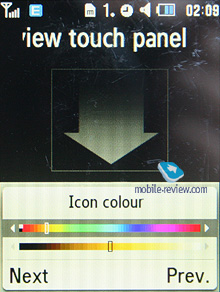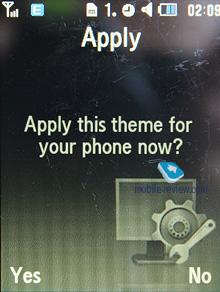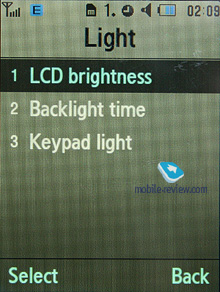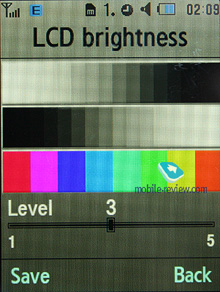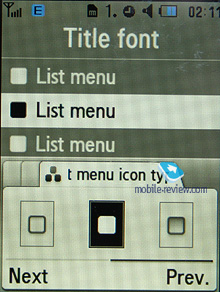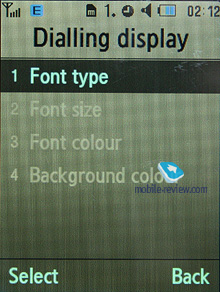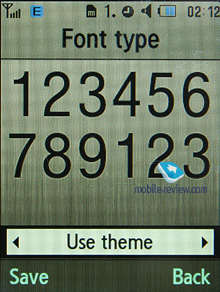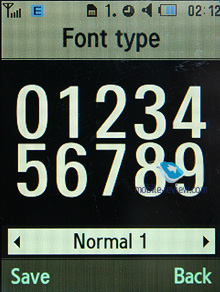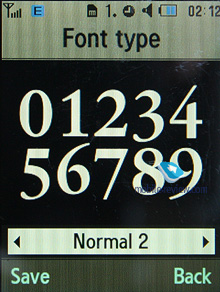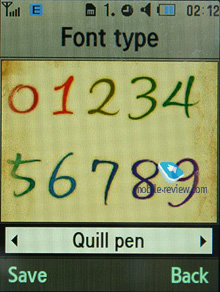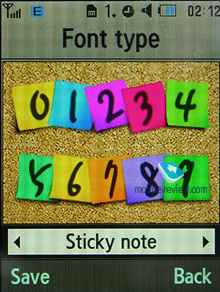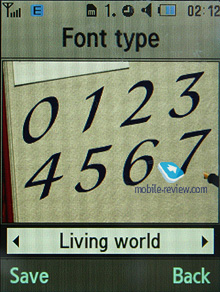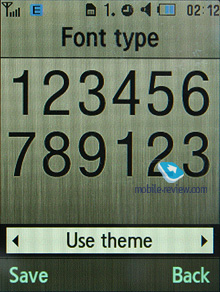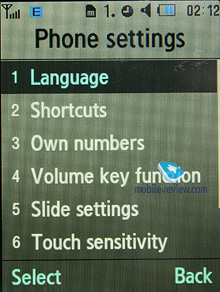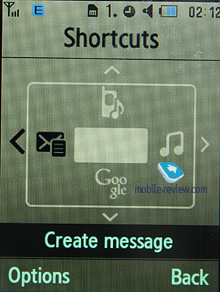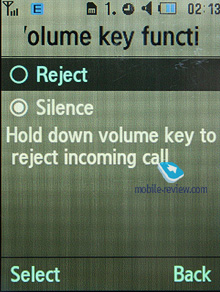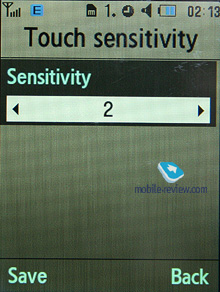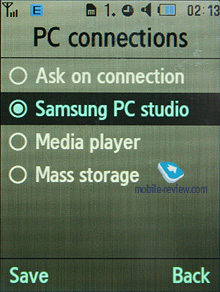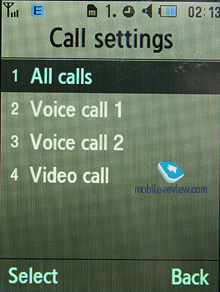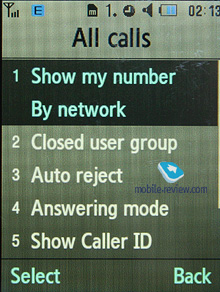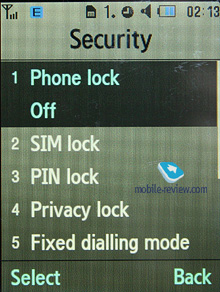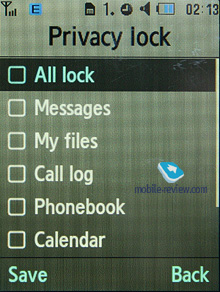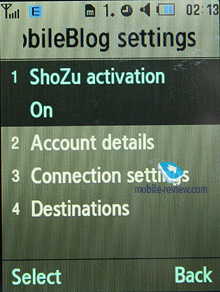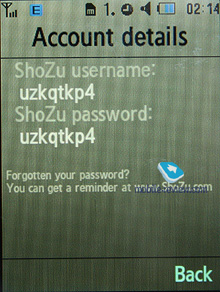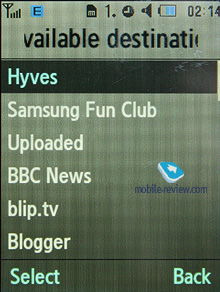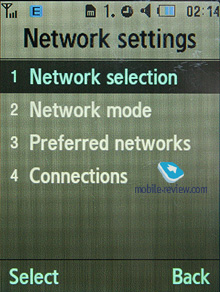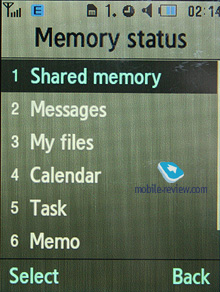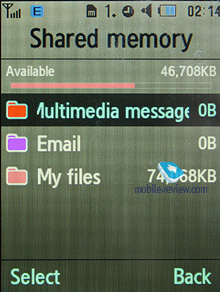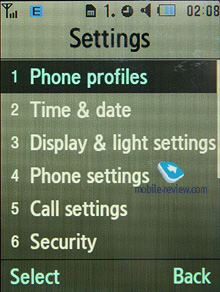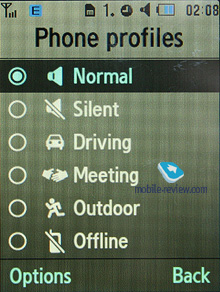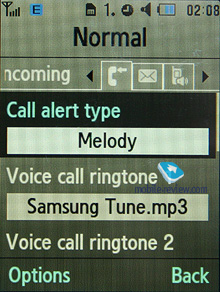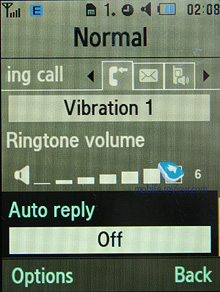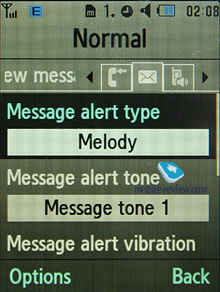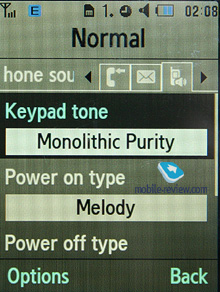|
|
Review of GSM/UMTS-handset Samsung G400
Live photos of Samsung G400
Table of contents:
- Positioning
- Design, Size, Controls
- Display
- Keypad
- Battery
- Connectivity
- Memory, Memory Cards
- Performance
- Camera
- External Display
- Menu, User Interface
- Phonebook
- Call log
- Messaging
- Organizer
- Multimedia
- MÐ3-player
- Entertainment
- Applications
- WAP
- Alarm clock
- File Manager (My files)
- Settings
- Impressions
Sales package:
- Handset
- 880 mAh Li-Ion battery
- Wired stereo-headset with a 3.5 mm socket
- USB data cable
- Software CD
- User Guide
Positioning
The G400 has come along as Samsung’s answer to Motorola’s ever-so-popular RAZR line-up. In fact their latest and greatest RAZR2 turned out to be a pretty likable phone with some good prospects. And in their turn, Samsung decided to show the world their vision of this phone type in the form of the G400. Rest assured, it’s not the same phone in a different wrapping, by any means – it simply adopts the way the RAZR2 V8 is positioned and looks a bit like it, but other than that the G400 has been built up from a scratch with the standards set by Motorola in mind.

And when you think of it, how it could be any different, considering the fact that Samsung have different hardware and production capacities on their plate, plus the G400 was scheduled for a much later release. There is another twist to this phone, which many seem to be missing – having used the clamshell design, that had been previously ignored by all phone makers but its inventor, Motorola, Samsung made a name for themselves in this segment By the way if you run a quick poll in a European city now on who created the first folding phone ever, I'm most positive many will tell you that Samsung did. But then sliders took over Samsung’s portfolio, and the folder-type phones no longer appeared all that fashionable. Although they kept churning out various phones housed in this design, none of them were flagship solutions. Now to the interesting part – the Samsung G400 is not an attempt to bring this form-factor back to the forefront; the important thing is that for the first time in a very long while Samsung have crafted a flagship-grade folding phone. Naturally, it’s “flagship-grade” in the way of its tech specs – you will surely notice how different the aesthetics of the U900 and G400 are. But this is actually the good news, since now they don’t have to be trapped in the dilemma on which one of these handsets should be senior. If these two phones were similar in the sense of form-factor, they would have had to throw a pretty decent camera out of the G400 and skimp on its functionality, so the resulting device would have been such a mixed bag – just remember the Samsung U600 and U300, while the former is still doing reasonably well, the latter has been withdrawn from the market, as nobody really cares about it.
Originally, the Samsung G400 was planned as a Soul-branded phone, completing this line-up with the U900 and U200 already in it. But somewhere along the way Samsung decided that a premium product shouldn’t have a lowish index, so they have “promoted” the U200 up to U800. Meanwhile the G400 had the Soul suffix all the way until recently – after all, it was too different from the rest of the line-up design-wise to share this “Soul” part with them.
Over at Samsung the fact that the G400 stands in one line with their flagship device, the U900 is not a very popular discussion theme. While they outline its quaint features and unique functions, Samsung prefer to keep mum on this phone on the whole. Obviously, they don’t want any competition within their own portfolio, but as far as I am concerned, these two phones would never have it anyway. People who are sweet on some particular form-fact will stick with it rather than trade their slider-style phones for some clamshells. Among the U900 users there is a lot of people who have been continuously changing their Samsung-branded sliders to new versions last couple of years. On the other hand, the audience for Samsung’s sliders doesn’t show a similar level of loyalty, which comes as no surprise seeing that the most interesting Samsung phones have been housed in the slider-type design so far.

This pops the questions whether the G400 is just a one-off, or Samsung are planning to start churning out these duos coming in different designs. The answer hinges solely on the sales of the Samsung G400. If this phone will be at least half as successful as the Samsung U900 (that soared up through the sales charts in a couple of months) Samsung won’t mind adopting other form-factors too.
The Samsung G400 will attract people looking for a quaint and off-the-wall phone, and actually it’s not such a narrow audience, as it includes both techi (who might like it for the touch-sensitive screen) and fashion aficionados.
Back to the table of contents >>>
Design, Size, Controls
The first material that comes to my mind when I’m looking at the G400 is liquid metal, although unlike the RAZR2 it doesn’t have any metallic accents at all, even the back cover is all plastic (even though Samsung haven’t been known for skimping on this part). But the good news is that the G400 is by no means a fingerprint-magnet, and on the whole it looks great especially in daylight, when all its facets shine and glitter.

The phone comes in a choice of four colors – Mirror Black (we used this trim for our review), Titanium Silver (similar to the black version, but a tad brighter), Luxury Gold, and Romantic Pink.

The G400’s plastic appears to be very similar to that used in early shipments of the Samsung U700 that had some serious problems with paint that tended to flake off. The reason was that they picked a wrong type of materials and launched it into production. With this in mind, I decided not to go easy on the G400 and threw it in one pocket with keys and tortured it a little with saline solutions with the pH level close to that of human sweat.


While it did pick up some small skin-deep scratches and nicks, most of them were smeared by the G400 casing design, so it looked pretty good after all my experiments. But as far as saline solutions go, the results weren’t all that clear-cut – the G400’s casing is lacquered, so generally it doesn’t react with salty water and other solutions. However, the areas around scratches do start reacting with them, but very passively at that. All in all, it will probably take 1.5 years of non-stop use and abuse in warmer climates to dissolve the G400’s casing. Apparently, this test is a mere approximation, but based on my experience, this phone won’t follow in the footsteps of the Samsung U700 on this front. It’s always good to know that Samsung have learned something from their past failures.

The plastic inset above the screen has the soft touch coating. All in all, the G400 doesn’t look or feel particularly light at 115 grams, but it’s not that much, especially since I expected it to be heavier when I first saw it. The handset measures up at 102.8x51.5x15.2 mm, which certainly makes it bigger than the RAZR2 V8 and not so elegant on top of that. Also we could rant about its tiny width that won’t help you when trying to flip the phone open with one hand (plus the dimples on the sides aren’t deep enough).



Housed on the left-hand side is the lanyard eyelet, microSD memory card slot covered by a plastic flap and the volume rocker (it has been moved down a notch, but is still comfortable to use while in a call). Turn the G400 to the right to find the multifunction socket for plugging in a charger or headset. Also there are the Hold key and dedicated camera button. The camera lens is mounted directly in the folder’s hinge – when the phone is open it stares right at you, and when it’s closed the lens is one the other side, allowing you to shoot without having to flick the G400 open.




Back to the table of contents >>>
Display
The key element of the Samsung G400 is its two-sided display with its external part being touch-sensitive. While screens like this have been showcased at numerous exhibitions over last several years, very few actually made it into mobile phones in view of their high production costs. For instance, the Motorola RAZR2 V8 employs a less sophisticated design with just three small touch-sensitive areas on its outer display. But think of it, what is better – having just three music controls on the front face, or a completely touch-friendly display? That’s right – the G400’s external screen is exactly the feature that sets it apart from many other today’s mobile phones.


As far as its technical specifications go, the G400’s display is no bells and whistles with a 2.2 inch diagonal and QVGA resolution (33x44 mm). It utilizes one backlight for both sides, which brings about a somewhat frustrating letdown – the outer display tends to get extremely washed out in the sun. On the other hand, the phone’s internal screen doesn’t have such problem, so probably it’s more due to the coating of the cover glass on the top.
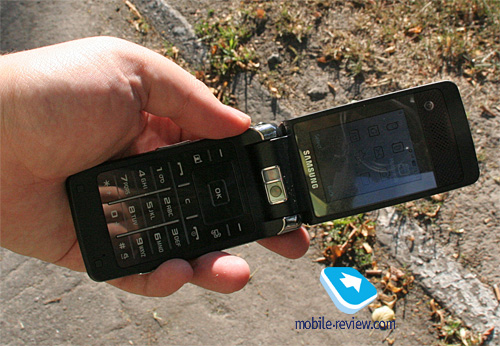
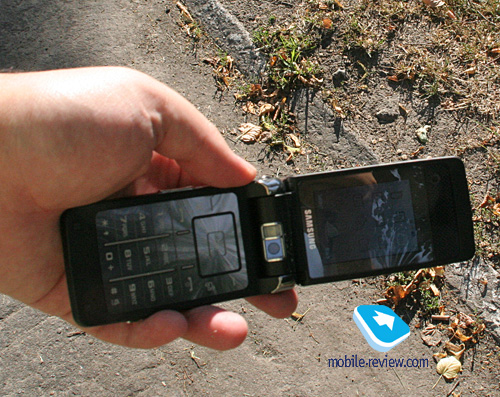
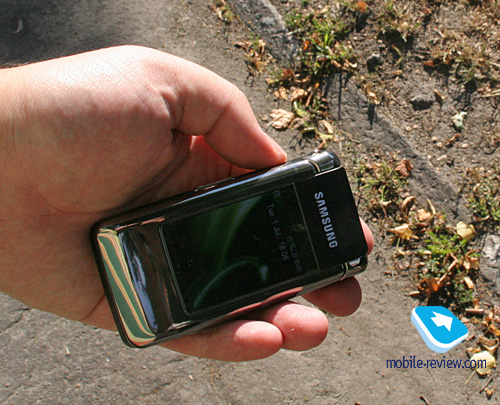
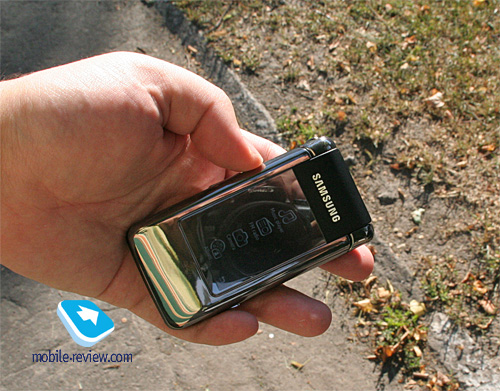
The display houses up to 9 text and 3 service lines. All fonts are large and very readable.
Back to the table of contents >>>
Keypad
The G400’s numeric keypad is housed on a solid metallic slab. The key travel distance isn’t al that great, but thanks to their generous size, they are pretty easy to handle. All buttons are evenly lit in white, which is well-visible in various environments.


Back to the table of contents >>>
Battery
The handset utilizes a 880 mAh Li-Ion cell. The maker rates G400’s cell as being good for up to 250 hours of standby and 2.5 hours of talk time. Within European networks the phone lasted around 2.5 days (one hour of calls total and regular use of its alarm clock). At the same time, in Moscow it managed to stay online for 2 days at 1.5 hours of calls. That’s why the G400 will stay up and running for at least 2 days with average load, however under certain circumstances you might squeeze up to 3 days of operation out of it. It takes the handset 2 hours to charge from empty to full. No higher-capacity cells are available for this model.


We managed to get 12 hours of non-stop music from the G400 (radio module on) with the highest volume settings and bundled headset plugged in.
Back to the table of contents >>>
Connectivity
Bluetooth. The model supports various profiles, such as Headset, Handsfree, Serial Port, Dial Up Networking, File Transfer, Object Push, Basic Printing, A2DP, Dual Profile Bluetooth, SIM Access. EDR-enabled Bluetooth 2.0 is onboard. Headset management doesn’t allow us to have any quibbles with it, everything is standard here. The G400 is one of Samsung’s first offerings to beam sound to two headsets simultaneously.
While in the USB Mass Storage mode, the G400 shows up on the desktop without requiring you to install any additional drivers, so right after plugging in it’s ready to work. Data connection speeds top out at 950 Kb/s.
You won’t be able to use the G400’s Bluetooth connectivity along with USB – it will require you to disable Bluetooth regardless of its status (connected and transferring data or not), which is very awkward.
There is also EDGE class 10 connectivity for GSM networks.
Back to the table of contents >>>
Memory, Memory Cards
The phone ships with 120 Mb of onboard memory – this storage space, give or take, is available to the user right out of the box. The memory card (hot-swappable) is displayed as a separate section, so you can’t access both memory types at a time. The G400 also comes with a file manager, enabling you to copy files to/from the memory card. In our test the handset had no problems handling our 8 Gb microSD memory card.

Back to the table of contents >>>
Performance
The G400’s performance is very typical as far as Samsung’s current device generation is concerned and is pretty moderate, although, on the other hand, we could hardly demand more from a product of this class. As it stands today, new applications can be uploaded only over the air (wap). Java apps can’t exceed 300 Kb in size.
Back to the table of contents >>>
Camera
The handset employs a 5 Mpix CMOS camera which stands very close to that found in the Samsung U900, while packing in a lot of new settings, that is, the G400 features the “Smile” feature. All in all, handling the handset’s camera is a treat, since its outer display turns into a viewfinder once you punch the dedicated camera button.

All camera settings are available right from the external screen, and since it’s touch-sensitive, you’ll have absolutely no trouble getting around all feature and modes of the G400’s camera. Should you want to use the zoom feature, for example, just press its thumbnail and it will float towards the center of the screen. Actually, it’s amazing how friendly the Samsung G400’s camera interface is – I found it somewhat similar to a simple digital compact. Probably the only counterpart to this marvel is the Sony Ericsson G900, whose touch-sensitive display allows changing settings on the fly as well, but the G400’s form-factor lends the phone a closer semblance to a digital camera.
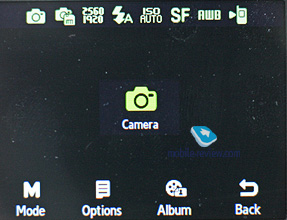
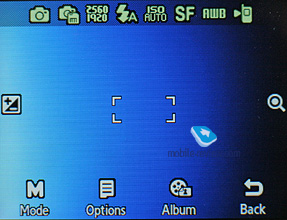
The camera application enjoys landscape layout, otherwise shooting with you would’ve been a pain. The G400 supports the following resolutions:
- 2560x1920 (5M)
- 2048x1536 (3M)
- 1600x1200(2M)
- 1280x960(1.3M)
- 640x480 (0.3M)
- 320x240
Several shooting modes are at your disposal:
- Single shot – default mode, the phone takes one shot at a time;
- Multi-shot – the phone takes a couple of shots in rapid succession (6, 9 or 15, two speeds, image resolution gets scaled down to VGA automatically);
- Mosaic shot – the G400 features a variety of mosaic shot types (image resolution gets scaled down to VGA automatically);
- Frame shot – while the resolution drops, you get access to the set of preinstalled frames;
- Panorama shot – the device can stitche together all parts of panorama on its own;
- Smile shot – the phone detects a smile and focuses on the face;
Other settings include special effects (Grey B&W, Sepia, Negative), white balance, ISO (50, 100, 200, 400, 800), timer (3, 5 or 10 seconds), antishake functionality (that kicks in very rarely, though), face recognition (which is what Samsung’s stand-alone digital cameras do), which works just fine, although fails at times when there are several people standing together. The macro mode is pretty good, just like on most other Samsung-branded devices.
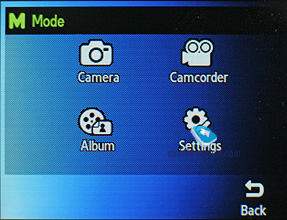
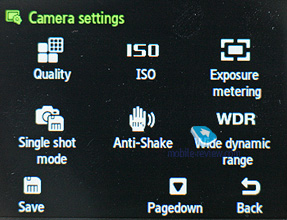

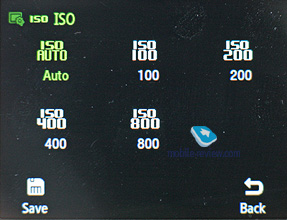
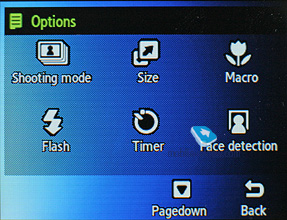
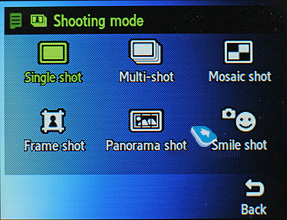
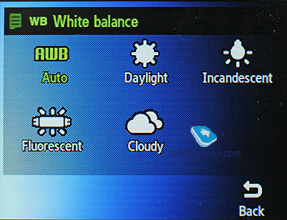
The LED flash is not particularly bright, but it does the job. It is quite another matter, though that shots taken in the dark are far from decent, as the matrix obviously lacks sensitivity.
Speaking of the G400’s image quality, we have an interesting situation – like we’d expect from Samsung, this device offers quite average quality, but that will still be enough for many, especially if you are not going to upload its shots to a PC.
 |
 |
| (+) enlarge, 2560x1920, JPEG |
(+) enlarge, 2560x1920, JPEG |
 |
 |
| (+) enlarge, 2560x1920, JPEG |
(+) enlarge, 2560x1920, JPEG |
 |
 |
| (+) enlarge, 2560x1920, JPEG |
(+) enlarge, 2560x1920, JPEG |
 |
 |
| (+) enlarge, 2560x1920, JPEG |
(+) enlarge, 2560x1920, JPEG |
 |
 |
| (+) enlarge, 2560x1920, JPEG |
(+) enlarge, 2560x1920, JPEG |
 |
 |
| (+) enlarge, 2560x1920, JPEG |
(+) enlarge, 2560x1920, JPEG |
 |
 |
| (+) enlarge, 2560x1920, JPEG |
(+) enlarge, 2560x1920, JPEG |
 |
 |
| (+) enlarge, 2560x1920, JPEG |
(+) enlarge, 2560x1920, JPEG |
 |
 |
| (+) enlarge, 2560x1920, JPEG |
(+) enlarge, 2560x1920, JPEG |
 |
 |
| (+) enlarge, 2560x1920, JPEG |
(+) enlarge, 2560x1920, JPEG |
 |
 |
| (+) enlarge, 2560x1920, JPEG |
(+) enlarge, 2560x1920, JPEG |
 |
 |
| (+) enlarge, 2560x1920, JPEG |
(+) enlarge, 2560x1920, JPEG |
 |
 |
| (+) enlarge, 2560x1920, JPEG |
(+) enlarge, 2560x1920, JPEG |
 |
 |
| (+) enlarge, 2560x1920, JPEG |
(+) enlarge, 2560x1920, JPEG |
 |
 |
| (+) enlarge, 2560x1920, JPEG |
(+) enlarge, 2560x1920, JPEG |
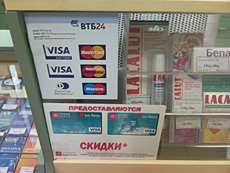 |
 |
| (+) enlarge, 2560x1920, JPEG |
(+) enlarge, 2560x1920, JPEG |
Video. For videos the G400 proposes exactly the same pool of effects as for the single shot mode, plus most settings are identical, bar the resolutions, there are only two available for the video mode: 320x240 pixels and 176x144 pixels (15 FPS). Maximum clip duration – up to 1 hour. Unfortunately, the G400 can’t shoot videos in VGA and in QVGA it does its job at a very marginal frame rate.
Back to the table of contents >>>
External Display
Like we already said, the G400’s best sides come to the surface when you start using its external screen. In most cases it’s filled with neon colors, so it may seem like it doesn't support the full palette of colors, but it’s not quite true. Using the Settings menu you can actually choose a wallpaper for the screen, icon colors, and even special effects.
While the G400 can lock its outer display automatically, you can do it manually by hitting the side-mounted key. However, I’m not sure whether you’ll actually have to use it – even when unlocked this screen won’t give you a lot of misclicks.
By default the screen shows an analog clock, but you can always change it to its digital counterpart. Also, you can tap the screen and move your finger around it to change the background. Plus the G400’s outer display can show the calendar, although its functionality is very limited, as it won’t list current and upcoming events in it.
The side-mounted volume buttons double as display sensitivity controls (on a 5-scale bar) – all in all, we were pleased with this ability of the G400.
Sitting right in the middle of the display is the menu shortcut icon. Actually, this display was originally designed for use in multimedia applications, and many calling options have been given short shrift. This way, on incoming call the G400’s outer display will show you only the caller’s name, number and a picture occupying half of its real estate. On top of that, you won’t be able to check out missed calls without unfolding the phone, same for messages. I suppose all these features will come along in the future, but not in the Samsung G400 – after all, it is Samsung’s first go at this double sided screen concept, and a pretty good one at that. All missed calls notifications and message alerts may be minimized.
The multimedia menu features four icons: Music player, FM-radio, Camera and Album. The player application here allows accessing exactly the same features as that running on the phone’s main display. The outer screen also sports semi-transparent music controls, plus the application itself may be minimized, so that you will be able to switch to your photo album, for example. All equalizer settings work on the external display too.
With the radio application here you can tune in to stations and jump to your favorite frequencies.
Album – this application allows you to view photos and videos from the phone’s memory and memory card. Unfortunately, you won’t be able to view them altogether, as it requires you to choose the memory type every time you open this menu. But we are more than willing to overlook this minor omission given what a gratifying viewing experience the G400 provides.
The good news is that the phone supports “heavy” video clips – so happened I had a couple of movies converted for the Apple iPhone on my memory card (H.264, mpeg4), so I gave it a go on G400’s the outer display. It turned out all these 600-700 Mb videos played smoothly and didn’t look jerky at all. Obviously, the G400’s display diagonal leaves much to be desired, but let’s face it, some media playerd have even smaller screens and still, people eagerly use them to watch their favorite videos.
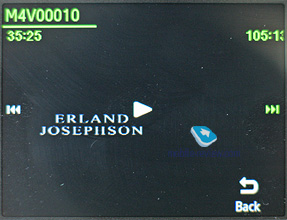

The bottom line on the G400’s outer display is this – it’s a marvel, with a well-designed, well-tuned and very straightforward interface that is unparalleled on today’s market. Regrettably, many of the phone’s calling options have been left behind in it, but I hope they will catch up in upcoming phones.
Back to the table of contents >>>
Menu, User Interface
The main menu is viewed as a grid (3x4). All sub-menus have horizontal lists - in the case of there being a sub-menu, you will see a pop-up list on the right of the highlighted item. You see which items are stored underneath, and once you press OK button, you will get there. When you lean the navigation key either left or right, you will be able to access the corresponding item immediately. Ergonomics of such solution is unquestionable, as you will have to make at least one key-press less. Also you can disable this view mode, so then the G400’s menu becomes just like any other menu system.
While surfing the menus you can take advantage of last item memorization in every sub-menu and the main menu. The handset will “remember” which function you addressed last time, and will highlight it automatically next time you enter the same menu item. For example, if you had selected call list in main menu and done some operations in it, then the next time you enter main menu you will have it highlighted in first place. But that’s not all; once you access it again you will see that sub-menu item which was addressed last will be highlighted too. It seems to be a simple thing, but it is not present in handsets produced by any other manufacturer.
When hovering over one or another item in the list you will see it highlighted, and font size (which is big already) will be increased.
Shortcut number navigation is supported, but there are more ways to navigate the menu in the G400. You can bind four different applications from the list, offered by manufacturer (you will not be able to bind java applications). There is no quick launch menu available in the G400 (Living world).
A separate button is set to toggle between applications while at the standby screen – for example you can switch to the music player and back. All in all, it’s still not multitasking, but at least it’s something you can deal with. At the same time, the G400 is the second phone after the Samsung F480 to allow the user to run numerous Java applications at a time. This way, you can minimize up to 5 applications and then restore them. Unfortunately there is no task manager with the list of all currently running apps, but other than that handling a couple of Java programs with the G400 is easy.

Themes. The G400 comes preinstalled with 3 themes, the default one meshes with the handset’s metallic details. Additionally the user can make used of the themes editor (available modes: basic and extended). In the former mode all you need to do is pick new wallpaper, tune some settings and voila, you have a new theme. But in the latter case, you will have the ability to adjust and modify every last thing, from icons color to fonts in specific menus, plus you get tips on how to make things look better in your personal theme.
Living World. This is a selection of personal wallpapers for each country (major cities might get unique wallpapers in the future, though it is not quite evident). When you will be in Moscow you will see Kremlin wharf and triumphal arch in case you’re in Paris, as for London – house of parliaments, and so on. Besides graphical assignation manufacturer decided to modify wallpaper depending on time of day: in the morning you see sun, and in the evening you see blinding lights of Kremlin wharf, cars will have their headlights turned on.
Time is not the only event that can be morphed into graphics. For example network reception level: good signal – sky is blue, no signal or weak one – sky is covered with clouds. At first you don’t pay much attention to this tiny feature, but after a month you will look on the sky instead of the standard bar, information reads instantly.
For new messages, missed events, or alarm clocks there is a special way of displaying, and which is powered with standard, traditional pop-up window with text. In daytime, such events will be demonstrated with help of airplane that will fly through the sky, and in the evening that would be fireworks. Color will change according to event type. At a glance this system looks kind of complicated, especially during its description, but in reality it is crystal clear and understandable.
When dialing a number you will see a small image with main theme displayed and animation of the dialed number.
Back to the table of contents >>>
Phonebook
Contacts can be accessed by pressing right soft key; you will see a list that contains all entries from both SIM-card and phone’s memory. The second tab comprises contact groups, so that you can switch to them in no time. If there is an assigned image, its thumbnail will be shown in the list – when scrolling though your contact list, a thumbnail will be shown only for a currently selected entry, and if there is none set, the G400 will use a default smilie.
The field beneath the name is the default number, which can be picked manually from the list of submitted numbers for a particular contact. Quick name search by first letters is supported; there can be up to twenty of those, for any language. Once you press OK key you will go into detailed view of the selected entry. There you will see a thumbnail, if any. It can be an image, a photo or a video clip. Each entry can have up to 5 phone numbers of different types (mobile, office, home, fax other), one of them will be main number (by default it is the first one you entered). Fiels aren’t fixed, meaning that you can choose their type manually (for example, submit two mobile and two home numbers for some contact).
There are two lines for First Name and Last Name (search is performed only by the former), these fields get merged when displayed in the general list, and First Name comes first. For example Eldar Murtazin will be shown only in this order. Length of each field is 20 characters for any supported input language. You can also switch languages on the fly when entering a name.
All entries, regardless of language, are sorted out in the following way – all contacts with headings made in a local language (Russian, for example) go first and then those with names in English. This is rather convenient and handy list sorting system. Taking into account fast language switch option during the search, it’s clear that no language will spoil the experience of working with this phone. The list can’t be sorted by first or last name, which is a letdown, characterizing Gumi’s products.
But let us return to the information entered for a contact. Apart from phone numbers, e-mail address (there may be several of them), a little text memo, address and other fields can be submitted on top of all that. Any music file (including MP3) can be picked as a ring tone for a contact. Three caller groups are provided by default with the possibility for creating any number of additional groups, setting a personal melody and image for each (by default there are three groups). SMS alerts are not customizable.
The phonebook is capable of holding up to 1000 contacts with filled in data fields. Even if all the available blanks are not used, the cap won’t get any bigger and will still make one thousand. It is possible to specify in the settings where all new numbers should be kept by default. There is also an option for moving entries from the SIM-card, although the reverse action is denied. According to the developers, PC (MS Outlook in particular) is best for data synchronization with the G400. Any contact in the form of SMS/MMS, mail message or other text file can be quickly sent through Bluetooth to another device. There are no problems with sending, and the phonebook entry gets beamed to another device, where it is read without any trouble.
The phonebook may contain a business card as well, though its structure copies all the fields found in a regular contact in the phone book.
There can be up to eight numbers in the fast dial list; separate numbers tied up with a single contact may appear on this list as well. The chosen entry (not of the phone number type) is displayed on the buttons as the subtitle. In case the contact you have picked has an image attached to it, then you see the entry’s name, which may get annoying when you have two different numbers of one contact mapped.
You can create any number of caller groups, assign up to 20 contacts and customize them with a picture and tune.
On an incoming call, caller ID picture occupies not the entire screen, but only a part of it. However, it still takes up a considerable area. This isn’t great, given the display’s stellar specifications.

Back to the table of contents >>>
Call log
Each of the given lists contains up to 30 phone numbers. There is a combined list of all the last calls with an icon indicating call type. Pressing the navi-pad horizontally, you can switch quickly between the lists. The date and time of the calls with a special note on duration are displayed in the extended view for separate entries. Calls from/to one number are grouped up, so that the number standing next to the call specifies total number of calls made. In order to access duration data you will need to call up detailed information on desired item. As always, the overall time of the calls and their cost can be viewed in this menu (in the case that the service has been enabled).
For individual numbers you can arrange a black list, which will reject all calls coming from these contacts.
Back to the table of contents >>>
Messaging
Much like other makers, over at Samsung they have forgone that artificial division into SMS-MMS types – you just start composing a message, and only then, depending on the contents, it is attributed to SMS or MMS. The menu still holds an option for switching message into MMS mode (for example when you need to send only text, but to an e-mail address, without calling up the bundled client).
The phone memory can hold up to as many as 500 messages; the handset supports EMS standard compatible with Nokia Smart Messaging. T9 text input comes in handy and is easy to use. While choosing recipient, you can either select a telephone number from your contacts or pick one from the call lists or groups. All messages are manageable, this means you are at liberty to move a certain number to your black list, in order to make sure all messages coming from that phone number will be deleted automatically; possibility for moving messages to any own folder is also at your disposal. For e-mail you can move not only addresses to the blacklist, but unwanted subjects as well.
There are no size restrictions set on received messages, though an outgoing message’s size is limited to 295 KB. As for additional services available with the G400, message rejection and message retrieval type options are onboard. All messages are stored in general dynamic memory, the same goes for e-mails.
Also there is a useful function for sending SOS-messages – when activated, should you find yourself in an emergency, after pressing the volume key four times, the message «I am in emergency. Please help me» will be sent to contacts submitted earlier, all incoming calls from these numbers upon sending the emergency message will be picked up automatically. Recipients (not more than 5), as well as number of Repeats may be set up manually, while text of the SOS-message is not customizable.
The bundled mail client is standard in all its components – 5 accounts and the maximum of 100 incoming messages; attachments are also handled by the phone, though there are also several caps – there’s no way you can receive a file more than 500 Kb big, or send one with size exceeding 300 kb. Received files can be viewed via the bundled browser. The G400 doesn't support html in emails, which breaks formatting of most letters you receive, so they become really awkward to read. The mail client found in Samsung-branded phones is now falling behind those embedded in Nokia’s and Sony Ericsson’s solutions.
Back to the table of contents >>>
Organizer
The phone’s memory can store as many as 100 events of one type – meeting. There are other event types as well, like anniversary and holiday, with the maximum capability of 50 events for each type. The G400 can also hold up to 20 high-priority events and the same number of private entries.
Day and time as well as end time of an event are indicated for each entry. Alert signal and its duration can be adjusted to your liking; repeatable events are available for setting up (repeat time is also manageable as well as the exceptions). The weekly and the monthly calendar views are very convenient with each type of the event having its own color.
Speaking of the organizer’s shortcomings, I cannot overlook the fact that when typing date and time for an event, the end time doesn’t change, which badly hurts its ease of use – other manufacturers make the due time shift automatically (by default any event takes one hour).
Back to the table of contents >>>
Multimedia
FM-radio. You can store up to 20 radio stations in the memory; the range of available frequencies is 87.5-108 MHz. Also, you can enjoy auto-tuning, but particular channels cannot have own names attached – they are always shown as the frequency numbers. The radio can work in handsfree mode, plus it enables you to set it up as an alarm clock, but regardless of how you are going to use it, a plugged-in headset is a must, since it doubles as an antenna. The radio implementation is fine, although it doesn’t pick up all stations equally well, but on balance, it is quite competent in comparison to other vendors’ offerings. The radio can be minimized.
RDS here displays only the station’s name in the general list, no advanced options available.
Voice recorder. You can record up to several hours of voice memos with the number of files being unlimited. Basically, limitations on recording duration are set by the user himself, though length of a single recording cannot exceed 1 hour. All the files are stored in a separate folder in the memory bank. The recorder performs well during lectures, conferences and presentations – I could even say that it is a partial substitute for a digital tape recorder.
Back to the table of contents >>>
MÐ3-player
The integrated mp3 player, supporting random, sequential and cyclic playback, is available on the phone. Mp3 files can be uploaded onto the handset both directly over Bluetooth and through the synch application or Windows Media Player. There are no limitations placed on tags and names of music files. Bitrates are also not something that really matters – the handset easily deals with all available formats and supports WMA, AAC, eAAC, eAAC+.
The title of the currently played back track is displayed as well as the number of the remaining tracks. The G400 also packs in a non-adjustable equalizer with 9 presets available. Among new additions is the Fade Out option, when towards the end of every track the sound will… well, fade out. Your tracks can be played through the stereo headset as well as the speakerphone. The volume bar has 10 scales on it. And of course the user can make up their own playlists. Player can work in minimized mode – in this case the display will show current track title and music controls, which is a good thing.
The player boasts the following filters: all tracks, recently players, most popular, artists, albums, genres and composers. The G400 also sports Album Arts support.
Speaking of new options, the player has obtained the rating system, enabling you to award any track with one to five stars. The maker has driven the integration with Windows Media Player as deep as it has never been before; actually, this manager also sports the rating system.
The bundled headset has a jack for plugging in own earphones and provides quite adequate sonic experience. Generally speaking, as a music-minded solution, the G400 comes close to Sony Ericsson’s Walkman range, especially as far as the first generation is concerned. Plus it holds its own against contemporary music-heavy phones, the G400’s sound quality is pretty decent, and it can well replace a dedicated device, especially if you are not an audiophile or tend to have music sessions in noisy environments.
Back to the table of contents >>>
Entertainment
Games – the handset comes preinstalled with three games, which are all demos (you will have to shell out for their full versions), these are: Tetris Mania, Minigolf Las Vegas, Paris Hilton Diamond Quest. The memory volume assigned for Java-applications is unlimited, at that you can remove any of the pre-installed games and upload new over the air (via WAP). Heap size can’t exceed 2 Mb, while the application can’t go over 1 Mb.
Back to the table of contents >>>
Applications
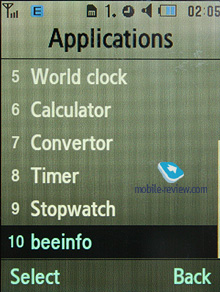
World time is displayed for two chosen cities.
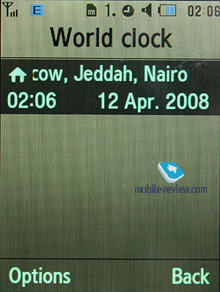
Calculator It divides, multiplies, subtracts and adds and does several more things – quite enough for a mobile calculator.
With the converter, you can operate with different units of measurements as well as with a number of currencies.
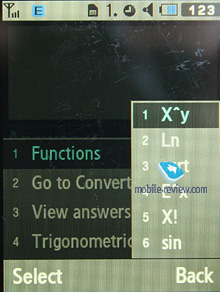
Countdown time and stopwatch have no bells and whistles.
Memo – standard text notes.
RSS Reader. This is a stand-alone utility for RSS feeds. However, it would make more sense if the RSS Reader was bound up with the web-browser, but this is not the case with the G400. This way, RSS links are not picked up by the browser, or sent directly to the application. You will need to manually submit a channel address in this app to subscribe, or enter a web address and let the application try to find an RSS channel on it.
While uploading your news feed, the G400 can upload text, as well as video and audio files, and it is up to you to set the size limit (by default – 5 Mb per file). Regrettably, there are no scheduled feed updates available, thus you will need to refresh the feed manually every time you need hot news.
Obviously with this application Samsung is having a first go at this field, and the truth is, it is not really functional or appealing the way it is in the G400. Similar solutions found in the phone from other makers pack more punch and are easier to manage.
Google. A stand-alone menu item for accessing Google search and GMail. Generally, the same things are available with handsets from other manufacturers, except for a dedicated menu item. In my judgement, this is nothing more but a marketing trick, however I can’t see anyone shouting “I have Google in my phone!” Who might find this feature essential in a phone?!
Back to the table of contents >>>
WAP
The handset comes with a wap-browser version 2.0 (NetFront 3.4), where apart from JavaScript support, fonts scaling (three types), Smart-Fit (single-column view), full-screen mode (all controls are hidden), page caching, they have embedded a new feature – on-screen ‘mouse’ pointer. Much like Nokia’s S60-powered handsets and Opera Mini, you can view pages with a tiny navigation window displayed. The browser itself packs a lot of goods under the hood and will be appreciated by most users.
Unlike the previous models, which used Picsel Viewer for browsing office documents, the G400 employs the bundled browser for these purposes. What we really like about it is that the user can perform local search within a document (any language). While it is a tad sluggish compared to Picsel Viewer, it is still pretty easy to handle. Personally, I couldn’t make up my mind on which solution I liked better – both of them have their strengths and weaknesses.
Back to the table of contents >>>
Alarm clock
The handset comes equipped with four alarm clocks, each of them can go off on certain weekdays. You can also pick one of the five tunes, or turn to MP3 tracks. In settings it is possible to enable auto power-up when any event triggers.
Back to the table of contents >>>
File Manager (My files)
That’s the place to search for all files such as music, pictures, video and sounds. Any uploaded file gets stored here. The disadvantage is that files sometimes are not displayed in the list immediately - in that case you will need to leave the menu and enter it again.
Files and folders can be viewed either as a list or thumbnails. You can mark any number of files. The handset supports Move, Copy and Delete operations, as well as various types of sorting (by type, name or size).
Memory card’s file structure is a slightly different story, as it can be accessed through the main menu, where each item features “Memory card” option.
The G400’s new feature is support for ShoZu that allows uploading any type of multimedia content to blogs – all it requires you to do is submit your logins and passwords to the services you use and then the handset will do the rest, enabling you to release, say, videos or photos right to you personal blog.
Back to the table of contents >>>
Settings
Traditionally this item boasts a standard set of options inside like password protection of selected sections (messages, short messages, organizer, etc.), backlighting duration and brightness, dialing display settings (no custom animations are available, one is assigned to the default theme – Living World).
Keypad light – there are three options at your disposal, one of them is Night mode, implying that backlighting will be active only between 5:00 PM and 9:00 AM and disabled during daytime. If you come to think of it, this feature is nothing more but an illusive replacement for ambient light indicator, which Motorola’s handsets are armed with.
Profiles – the G400 comes with a fully functional system of profiles, including Flight Mode. Every profile is customizable – you can pick ring tone, incoming message alert and adjust the volume level.
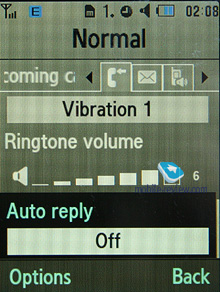
Mobile Tracker – submit a phone number, where notifications will be sent to in case SIM-card was changed – that message will contain number of the SIM-card being used with the handset. This section is protected with password, so that no one other than you or someone else who knows the password could disable the Tracker. Should your device have the SIM-card switched once, the specified number will receive one message instantly, and one more each time a new card is plugged in. A fetching feature which can prove to be of much help in case the handset is lost or stolen.
The Fold action settings item features options which can be assigned to opening and closing. In other words, they determine whether the slider is active or not.
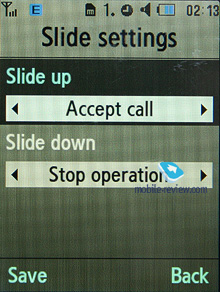
Apart from the standard set of wallpapers for the standby screen, you can make up animated wallpapers of your own, and it doesn’t take a rocket scientist to create one. All you need are 9 snaps, then you adjust time spans between different frames and transition effects (there is a slew of them available, like Butterfly, Paper place etc). And the animation you get is pretty amusing; it will work on the standby screen as long as the display is on.
Back to the table of contents >>>
Impressions
The reception quality put up by the G400 is in line with other Samsung-branded devices. The ringtone volume is quite decent, as it can be heard in various environments. The silent alert is average strength-wise, no significant improvements have been made here.
This phone has already arrived and is selling for around 400 Euro, which is a bit above the price for the Samsung U900 Soul. But going for the G400 are its new form-factor and a touch-sensitive external screen, which is actually its main feature. As far as its crucial drawbacks go, the Samsung G400 doesn’t have any, at least compared to the U900 Soul’s functionality – in fact it’s the same phone but in a different wrapping.
Recently all phone manufacturers have caught the slider fever, so the niche of clamshells has been pretty much empty. This makes the Samsung G400 a clear winner in the race for consumers’ pockets, as this phone is simply second to none at the moment. As far as I am concerned, the Samsung G400 is one of this year’s best offerings, with the Motorola RAZR2 V8 being its only real rival. In the case of the latter you are getting a more petite and less functional device at a much lower price point (330 Euro or even less), but the choice isn’t all that clear-cut – both phones have their own special flavors. All in all, if you are in the market for a clamshell, you are obligated to have the G400 at the top of your shortlist.
Related links:
Back to the table of contents >>>
Eldar Murtazin (eldar@mobile-review.com)
Translated by Oleg Kononosov (oleg.kononosov@mobile-review.com)
Published — 01 September 2008
Have something to add?! Write us... eldar@mobile-review.com
|
News:
[ 31-07 16:21 ]Sir Jony Ive: Apple Isn't In It For The Money
[ 31-07 13:34 ]Video: Nokia Designer Interviews
[ 31-07 13:10 ]RIM To Layoff 3,000 More Employees
[ 30-07 20:59 ]Video: iPhone 5 Housing Shown Off
[ 30-07 19:12 ]Android Fortunes Decline In U.S.
[ 25-07 16:18 ]Why Apple Is Suing Samsung?
[ 25-07 15:53 ]A Few Choice Quotes About Apple ... By Samsung
[ 23-07 20:25 ]Russian iOS Hacker Calls It A Day
[ 23-07 17:40 ]Video: It's Still Not Out, But Galaxy Note 10.1 Gets An Ad
[ 19-07 19:10 ]Another Loss For Nokia: $1 Billion Down In Q2
[ 19-07 17:22 ]British Judge Orders Apple To Run Ads Saying Samsung Did Not Copy Them
[ 19-07 16:57 ]iPhone 5 To Feature Nano-SIM Cards
[ 18-07 14:20 ]What The iPad Could Have Looked Like ...
[ 18-07 13:25 ]App Store Hack Is Still Going Strong Despite Apple's Best Efforts
[ 13-07 12:34 ]Infographic: The (Hypothetical) Sale Of RIM
[ 13-07 11:10 ]Video: iPhone Hacker Makes In-App Purchases Free
[ 12-07 19:50 ]iPhone 5 Images Leak Again
[ 12-07 17:51 ]Android Takes 50%+ Of U.S. And Europe
[ 11-07 16:02 ]Apple Involved In 60% Of Patent Suits
[ 11-07 13:14 ]Video: Kindle Fire Gets A Jelly Bean
Subscribe
|
